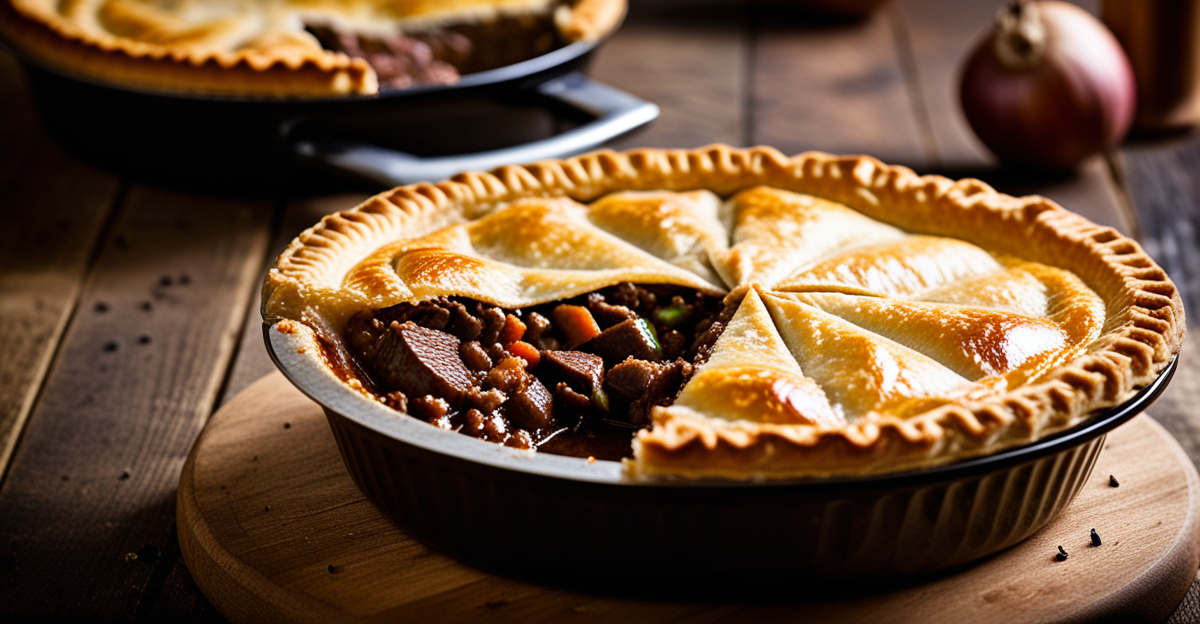Essential Ingredients and Preparation Methods
Selecting the right steak and kidney pie ingredients is crucial to crafting an authentic steak and kidney pie that satisfies both in taste and texture. The cornerstone lies in choosing premium cuts of beef and kidneys. Opt for tender cuts like chuck or blade steak, which offer rich flavour and a pleasant chew without becoming tough. When it comes to kidneys, lamb kidneys are preferred for their delicate taste and softer texture, though beef kidneys also work well if properly prepared.
Preparing the meats requires careful trimming and soaking. Trim excess fat and sinew from the steak for a cleaner bite. Kidney preparation involves soaking in cold water or milk for at least an hour to soften their robust flavour and remove any lingering bitterness. This process ensures that the resulting pie is balanced rather than overpowering.
In the same genre : How Can British Cuisine Influence Modern Cooking Trends Worldwide?
Beyond the meats, supporting ingredients play a vital role. Fresh onions provide sweetness and depth, while a good-quality beef stock enriches the filling’s body. Traditional herbs like thyme and bay leaf complement the rich, hearty nature of the pie, enhancing rather than masking the core flavours. Mastery of these elements guarantees the foundation for an authentic steak and kidney pie.
Essential Ingredients and Preparation Methods
Selecting the right steak and kidney pie ingredients is foundational to crafting an authentic steak and kidney pie. The ideal cuts balance flavour and texture: choose well-marbled beef to ensure tenderness and rich taste, paired with fresh, properly prepared kidneys for depth without overpowering the pie. Quality kidneys—often lamb or beef—should be thoroughly trimmed and soaked in cold water or milk to mellow their strong flavour and firm the texture.
In the same genre : What are the key techniques for making a proper Welsh rarebit?
Proper meat preparation impacts the final dish greatly. After soaking, kidneys must be finely trimmed of sinew and excess fat. Beef should be cut into uniform pieces for even cooking. Supporting ingredients also require careful selection; sweet onions and a robust stock add essential layers of flavour, while classic seasonings like black pepper and thyme complement the meaty richness.
These choices in ingredient quality and preparation methods create the base for an authentic steak and kidney pie, where every component works cohesively to deliver both satisfying texture and bold taste. This attention to meat preparation and ingredient selection forms the core that allows further techniques to build on intensifying flavour and tenderness.
Proven Techniques for Rich Flavour and Tender Meat
Mastering steak and kidney pie seasoning unlocks complex, savory layers essential to an authentic steak and kidney pie. Begin by seasoning the trimmed meat with salt, freshly cracked black pepper, and traditional herbs such as thyme and bay leaves. Aromatics like finely chopped onions and garlic elevate the flavour, creating a robust base for the filling.
Browning the meat properly is crucial. This Maillard reaction develops deep, caramelized notes that enrich the pie’s overall taste. Ensure the meat is dry before searing over medium-high heat in batches to avoid steaming. Once browned, slow cooking tenderises meat by breaking down connective tissue gently over low heat. This technique melds flavours and ensures the beef and kidney become melt-in-your-mouth tender.
After slow cooking, deglaze the pan with a splash of stock or ale to release flavorful browned bits from the base. Reducing this liquid concentrates savory notes, thickening the filling naturally. Patience here pays dividends: a well-seasoned, slow-cooked filling brings unparalleled depth and tenderness, forming the heart of a truly satisfying pie.
Proven Techniques for Rich Flavour and Tender Meat
To develop the deep, hearty taste expected from traditional steak and kidney pie seasoning, begin by seasoning the meat well before cooking. A combination of salt, pepper, and finely chopped herbs like thyme and bay leaf imbues the filling with rich aromatics that complement the steak and kidney pie ingredients.
Browning the trimmed steak and kidneys in a hot pan is essential. This Maillard reaction creates a flavorful crust that intensifies the overall dish. After browning, slow cooking the meat gently in beef stock allows tough connective tissues to break down, resulting in tender meat without dryness. This slow cooking technique also ensures the filling’s juices mingle perfectly with the seasoning.
Deglazing the pan with a splash of red wine, ale, or stock lifts all the caramelized bits from the base, concentrating flavour in the filling. Reducing the liquid over low heat thickens it into a glossy sauce that coats the meat luxuriously.
Such slow cooking approaches and careful seasoning transform simple meat preparation into an enriched, melt-in-the-mouth experience. These expert recipe tips ensure every bite of the pie bursts with satisfying, authentic flavour and tenderness.
Essential Ingredients and Preparation Methods
The foundation of an authentic steak and kidney pie hinges on precise ingredient selection and thorough meat preparation. Opt for cuts like chuck or blade steak for their ideal balance of tenderness and flavour. For kidneys, lamb kidneys are preferred, prized for their milder taste; beef kidneys require extra care to avoid overpowering the dish.
Meat preparation begins with meticulous trimming—removing excess fat and sinew to prevent toughness. Soaking kidneys in cold water or milk for at least an hour is essential to mellow their strong flavour and firm up texture. This step significantly improves the overall balance of the pie, ensuring the kidneys complement the beef rather than dominate.
Supporting steak and kidney pie ingredients like fresh onions and a quality beef stock elevate the filling’s richness. Aromatic herbs such as thyme and bay leaf bring subtle earthiness without masking the core meat flavours. Seasoning with freshly cracked black pepper and salt at this stage primes the filling for deeper taste during cooking.
This careful ingredient selection and preparation method sets the stage for crafting a traditional steak and kidney pie with authentic, layered flavours and tender, well-balanced meat.
Essential Ingredients and Preparation Methods
Choosing the right steak and kidney pie ingredients forms the foundation for a truly satisfying pie. For authentic steak and kidney pie, use cuts like chuck or blade steak, prized for their balance of flavour and tenderness. Lamb kidneys are preferred for their milder taste, but beef kidneys can also feature if properly prepared.
Meat preparation is essential to ensure the filling’s quality. After trimming away excess fat and sinew, kidneys should be soaked in cold water or milk for at least an hour. This soaking process reduces their strong, sometimes bitter flavour, moderating the kidney’s intensity while preserving its texture. Beef should be cut into uniform cubes to promote even cooking during slow simmering.
Supporting ingredient selection also elevates the pie. Sweet onions add natural sweetness and depth, while fresh herbs like thyme and bay leaf provide classic aromatic undertones. Using a rich, homemade or high-quality beef stock creates a robust base. Proper seasoning with salt and pepper complements the natural flavours of the meat and helps meld all ingredients into a balanced, hearty filling.
Careful attention to ingredient sourcing and preparation guarantees the authentic steak and kidney pie experience, setting a strong stage for techniques that will further enhance flavour and texture.
Essential Ingredients and Preparation Methods
Selecting the right steak and kidney pie ingredients is vital for an authentic steak and kidney pie. Begin with choosing prime cuts of beef, such as chuck or blade steak, prized for their balance of flavour and tenderness. Lamb kidneys are typically preferred because of their milder taste and softer texture. Beef kidneys can be used but require extra care in meat preparation to avoid overpowering the pie.
Proper trimming is essential: remove excess fat and sinew from both steak and kidneys to improve texture and prevent toughness. Soaking kidneys in cold water or milk for at least an hour is crucial; this reduces bitterness and firms the texture, making the kidneys complement rather than dominate the filling. Uniformly cutting the beef into similar-sized pieces ensures even cooking during slow simmering.
Supporting ingredient selection is equally important. Sweet onions add natural depth, while a rich beef stock builds a hearty base. Classic herbs like thyme and bay leaf provide subtle aromatics that enhance rather than mask the meat’s flavour. Seasoning with freshly cracked black pepper and salt ties all elements together, preparing the mixture for the slow cooking process that develops authentic steak and kidney pie depth and tenderness.
Essential Ingredients and Preparation Methods
Selecting the best steak and kidney pie ingredients starts with the right cuts of meat. Choose blade or chuck steak for their balance of tenderness and flavour, essential to an authentic steak and kidney pie. Opt for lamb kidneys due to their milder, less robust taste, but if using beef kidneys, thorough meat preparation is critical to avoid overpowering the filling.
Meat preparation involves meticulous trimming—removing all excess fat and sinew to enhance texture and mouthfeel. The kidneys then require soaking in cold water or milk for at least an hour to reduce bitterness and firm their texture. This soaking ensures the kidneys meld harmoniously with the steak rather than dominate.
Supporting ingredients elevate the pie’s depth. Sweet, finely chopped onions bring natural sweetness and body to the filling. High-quality beef stock adds richness and a strong savoury backbone. Seasoning with salt, black pepper, and traditional herbs like thyme and bay leaf amplifies complexity without overshadowing the main components.
In sum, thoughtful ingredient selection combined with expert meat preparation produces the foundation for a classic, well-balanced, and flavourful traditional steak and kidney pie. Proper techniques here set the stage for achieving ideal texture and authentic taste.











